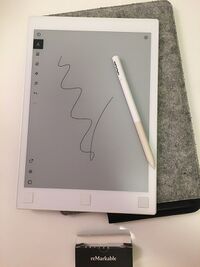ReMarkable 1 (remarkable-zero-gravitas): Difference between revisions
| (One intermediate revision by the same user not shown) | |||
| Line 62: | Line 62: | ||
== Installation == | == Installation == | ||
<!-- add more sections below as necessary, e.g. Wifi, photos, ... --> | <!-- add more sections below as necessary, e.g. Wifi, photos, ... --> | ||
Get Kernels and Uboot here: | |||
https://developer.remarkable.com/links | |||
== Users owning this device == | == Users owning this device == | ||
| Line 67: | Line 71: | ||
== See also == | == See also == | ||
[https://github.com/reMarkable/linux Kernel] for reMarkable1&2. | |||
[https://www.davisr.me/projects/parabola-rm/install-guide-latest.pdf Guide] on how to compile Parabola for remarkable. | [https://www.davisr.me/projects/parabola-rm/install-guide-latest.pdf Guide] on how to compile Parabola for remarkable. | ||
[https://www.davisr.me/projects/parabola-rm/ Parabola-rM] a fully working linux distro for remarkable | [https://www.davisr.me/projects/parabola-rm/ Parabola-rM] a fully working linux distro for remarkable | ||
Latest revision as of 01:08, 22 March 2025
 Sauer202, CC BY-SA 4.0 via Wikimedia Commons | |
| Manufacturer | reMarkable |
|---|---|
| Name | 1 |
| Codename | remarkable-zero-gravitas |
| Released | 2016 |
| Type | ebook reader |
| Hardware | |
| Chipset | Freescale i.MX6 SoloLite |
| CPU | 1x 1 GHz Cortex-A9 |
| GPU | PXP + EPDC |
| Display | 1872x1404 (~226 PPI) 10.3" Electrophoretic Display |
| Storage | 8GB |
| Memory | 512MB DDR3L |
| Architecture | armv7 |
| Software | |
| Original software | Codex |
| postmarketOS | |
| Category | testing |
| Pre-built images | no |
| Mainline | no |
| Flashing |
Broken |
|---|---|
| USB Networking |
Broken |
| Internal storage |
No data |
| SD card |
No data |
| Battery |
Works |
| Screen |
Works |
| Touchscreen |
Works |
| Multimedia | |
| 3D Acceleration |
No data |
| Audio |
No data |
| Camera |
No data |
| Camera Flash |
No data |
| Connectivity | |
| WiFi |
Works |
| Bluetooth |
No data |
| GPS |
No data |
| NFC |
No data |
| Modem | |
| Calls |
No data |
| SMS |
No data |
| Mobile data |
No data |
| Miscellaneous | |
| FDE |
Broken |
| USB OTG |
No data |
| HDMI/DP |
No data |
| Sensors | |
| Accelerometer |
No data |
| Magnetometer |
No data |
| Ambient Light |
No data |
| Proximity |
No data |
| Hall Effect |
No data |
| Haptics |
No data |
| Barometer |
No data |
| This device is based on the i.MX6 SoloLite. See the SoC page for common tips, guides and troubleshooting steps |
Contributors
- Ayakael
Maintainer(s)
- Ayakael
What works
What does not work
How to enter flash mode
The SoC may boot from multiple sources depending on its initial state. If only the power button is pressed, the SoC will look for a bootloader on a protected eMMC partition (mounted by the kernel as /dev/mmcblk1boot0). However, if the user holds the center facial button while the power button is pressed, the SoC will instead enter recovery mode. In this mode, the SoC will await a payload to be delivered over USB with the imx_usb utility. Regardless of how the bootloader gets into memory, the sequence below is followed.
1. The SoC ROM loads and executes the bootloader
2. The bootloader loads and executes the kernel
3. The kernel mounts the filesystem and starts the init program as PID1
Installation
Get Kernels and Uboot here:
https://developer.remarkable.com/links
Users owning this device
See also
Kernel for reMarkable1&2.
Guide on how to compile Parabola for remarkable.
Parabola-rM a fully working linux distro for remarkable